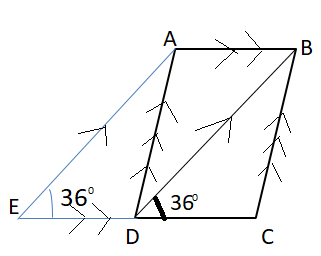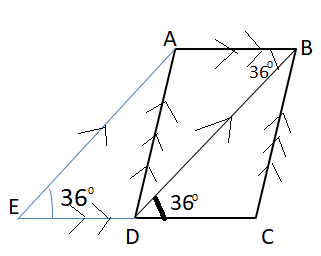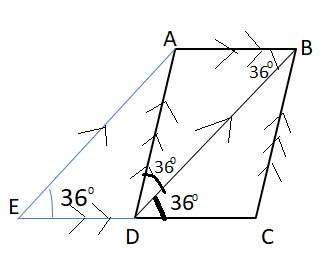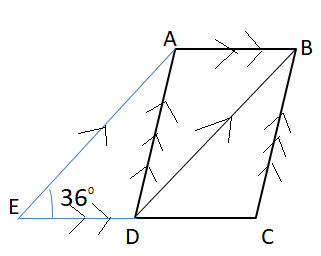
Answer
498.9k+ views
HINT- In order to solve such types of questions the key concept is that we should know the basic properties of rhombus and parallelogram along with the proper understanding of corresponding angles and alternate angles.
Complete step-by-step answer:
Corresponding angles - When two parallel lines (AE and BD) are crossed by another line EC (which is called the Transversal), the angles (∠BDC = ∠AED) in matching corners are called corresponding angles.

⇒ ∠BDC = ∠AED = ${36^0}$ (corresponding angles of AE and BD.)
⇒ We know that ABCD is a rhombus, so AB∥DC
Alternate angles-
Alternate angles are angles that are in opposite positions relative to a transversal (BD) intersecting two parallel lines (AB and DC).

⇒ ∠ABD = ∠BDC = ${36^0}$ (Alternate angles)
Isosceles triangle- The Isosceles Triangle Theorem states: If two sides of a triangle are equal, then the angles opposite those sides are equal.
⇒ ∠ADB = ∠ABD = ${36^0}$ (Base angles of isosceles, since AB =DC)

⇒ In △ADB,
Using formula $\left( {{\text{n - 2}}} \right) \times {180^0}$ , Here, number of side n=3
So sum of internal angle of triangle is ${180^0}$
⇒ ∠BAD + ∠ABD + ∠ADB = ${180^0}$
Substituting all the values we get,
⇒ ∠BAD + ${36^0}$ + ${36^0}$= ${180^0}$
⇒ ∠BAD = ${180^0}$- ${36^0}$- ${36^0}$
∴ ∠BAD = ${108^0}$
Hence option C is correct.
Note- In Order to solve such types of questions we should know that in a rhombus, opposite sides are parallel and opposite angles are equal. Moreover, all the sides of a rhombus are equal in length while a parallelogram is a quadrilateral with two pairs of parallel sides. The opposite sides of a parallelogram are equal in length and the opposite angles are equal in measure
Complete step-by-step answer:
Corresponding angles - When two parallel lines (AE and BD) are crossed by another line EC (which is called the Transversal), the angles (∠BDC = ∠AED) in matching corners are called corresponding angles.

⇒ ∠BDC = ∠AED = ${36^0}$ (corresponding angles of AE and BD.)
⇒ We know that ABCD is a rhombus, so AB∥DC
Alternate angles-
Alternate angles are angles that are in opposite positions relative to a transversal (BD) intersecting two parallel lines (AB and DC).

⇒ ∠ABD = ∠BDC = ${36^0}$ (Alternate angles)
Isosceles triangle- The Isosceles Triangle Theorem states: If two sides of a triangle are equal, then the angles opposite those sides are equal.
⇒ ∠ADB = ∠ABD = ${36^0}$ (Base angles of isosceles, since AB =DC)

⇒ In △ADB,
Using formula $\left( {{\text{n - 2}}} \right) \times {180^0}$ , Here, number of side n=3
So sum of internal angle of triangle is ${180^0}$
⇒ ∠BAD + ∠ABD + ∠ADB = ${180^0}$
Substituting all the values we get,
⇒ ∠BAD + ${36^0}$ + ${36^0}$= ${180^0}$
⇒ ∠BAD = ${180^0}$- ${36^0}$- ${36^0}$
∴ ∠BAD = ${108^0}$
Hence option C is correct.
Note- In Order to solve such types of questions we should know that in a rhombus, opposite sides are parallel and opposite angles are equal. Moreover, all the sides of a rhombus are equal in length while a parallelogram is a quadrilateral with two pairs of parallel sides. The opposite sides of a parallelogram are equal in length and the opposite angles are equal in measure
Recently Updated Pages
Fill in the blanks with suitable prepositions Break class 10 english CBSE

Fill in the blanks with suitable articles Tribune is class 10 english CBSE

Rearrange the following words and phrases to form a class 10 english CBSE

Select the opposite of the given word Permit aGive class 10 english CBSE

Fill in the blank with the most appropriate option class 10 english CBSE

Some places have oneline notices Which option is a class 10 english CBSE

Trending doubts
Fill the blanks with the suitable prepositions 1 The class 9 english CBSE

How do you graph the function fx 4x class 9 maths CBSE

When was Karauli Praja Mandal established 11934 21936 class 10 social science CBSE

Which are the Top 10 Largest Countries of the World?

What is the definite integral of zero a constant b class 12 maths CBSE

Why is steel more elastic than rubber class 11 physics CBSE

Distinguish between the following Ferrous and nonferrous class 9 social science CBSE

The Equation xxx + 2 is Satisfied when x is Equal to Class 10 Maths

Differentiate between homogeneous and heterogeneous class 12 chemistry CBSE





